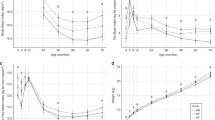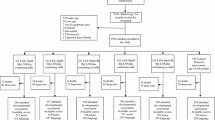Abstract
Little research has focused on infant developmental effects, other than growth, of formulas that differ substantially in the form of protein. To examine development of infants fed formulas differing in free amino acid content, we randomized 0.5-month-old infants (n = 79) to either a control group who fed only cow milk formula (CMF) during the first 8 months (CMF8), or to one of two experimental groups: one experimental group fed extensively protein hydrolyzed formula (EHF) for 1–3 months during first 4.5 months (EHF1-3) of life, and the other fed EHF for 8 months (EHF8). The Mullen Scales of Early Learning were administered monthly from 1.5 to 8.5 months to assess fine (FM) and gross (GM) motor control, receptive (RL) and expressive (EL) language, visual reception (VR), and an early learning composite (ELC). Across the 5.5–8.5-month time period, when compared to CMF8 infants, GM scores in EHF1-3 infants averaged 1.5 points higher (95 % CI 0.1, 3.0) and in EHF8 infants 2.2 points higher (95 % CI 0.3, 4.0). Similarly, VR scores averaged 1.9 points higher (95 % CI 0.1, 3.8) in EHF1-3 infants and 2.2 points higher (95 % CI −0.2, 4.5) in EHF8 infants. EHF8 infants’ RL scores averaged 1.8 points lower (95 % CI 0.1, 3.6) than CMF8 infants. These data suggest that the form of protein in infant formula may impact cognitive development and that the higher free amino acid content in breast milk may be a contributing factor to the differential cognitive development between breastfed and CMF-fed infants.
Clinical Trial Registration: clinicaltrials.gov NCT00994747.

Similar content being viewed by others
References
Agostoni C, Carratu B, Boniglia C, Riva E, Sanzini E (2000) Free amino acid content in standard infant formulas: comparison with human milk. J Am Coll Nutr 19:434–438
Andres A, Cleves MA, Bellando JB, Pivik RT, Casey PH, Badger TM (2012) Developmental status of 1-year-old infants fed breast milk, cow’s milk formula, or soy formula. Pediatrics 129:1134–1140
Auestad N, Scott DT, Janowsky JS, Jacobsen C, Carroll RE, Montalto MB, Halter R, Qiu W, Jacobs JR, Connor WE, Connor SL, Taylor JA, Neuringer M, Fitzgerald KM, Hall RT (2003) Visual, cognitive, and language assessments at 39 months: a follow-up study of children fed formulas containing long-chain polyunsaturated fatty acids to 1 year of age. Pediatrics 112:e177–e183
Baldéon ME, Mennella JA, Flores N, Fornasini M, San Gabriel A (2014) Free amino acid content in breast milk of adolescent and adult mothers in Ecuador. SpringerPlus 3:104
Brosnan JT, Brosnan ME (2006) The sulfur-containing amino acids: an overview. J Nutr 136:1636S–1640S
Chaudhuri RN, Ghosh BN, Chatterjee BN (1989) Diet intake patterns of non-Bengali Muslim mothers during pregnancy and lactation. Indian J Public Health 33:82–83
Deoni SC, Dean DC 3rd, Piryatinsky I, O’Muircheartaigh J, Waskiewicz N, Lehman K, Han M, Dirks H (2013) Breastfeeding and early white matter development: a cross-sectional study. Neuroimage 82:77–86
Dewey KG (1998) Growth characteristics of breast-fed compared to formula-fed infants. Biol Neonate 74:94–105
Gonzalez EM, Penedo LA, Oliveira-Silva P, Campello-Costa P, Guedes RC, Serfaty CA (2008) Neonatal tryptophan dietary restriction alters development of retinotectal projections in rats. Exp Neurol 211:441–448
Hawley LE, Canolty NL, Dunkley WL (1978) Fatty acid composition of prepared infant formulas. J Am Diet Assoc 72:170–173
Hoffman DR, Boettcher JA, Diersen-Schade DA (2009) Toward optimizing vision and cognition in term infants by dietary docosahexaenoic and arachidonic acid supplementation: a review of randomized controlled trials. Prostaglandins Leukot Essent Fatty Acids 81:151–158
Jensen RG, Hagerty MM, McMahon KE (1978) Lipids of human milk and infant formulas: a review. Am J Clin Nutr 31:990–1016
Keim SA, Daniels JL, Siega-Riz AM, Herring AH, Dole N, Scheidt PC (2012) Breastfeeding and long-chain polyunsaturated fatty acid intake in the first 4 post-natal months and infant cognitive development: an observational study. Matern Child Nutr 8:471–482
King JC Jr, Cummings GE, Guo N, Trivedi L, Readmond BX, Keane V, Feigelman S, de Waard R (2007) A double-blind, placebo-controlled, pilot study of bovine lactoferrin supplementation in bottle-fed infants. J Pediatr Gastroenterol Nutr 44:245–251
Koletzko B, von Kries R, Closa R, Escribano J, Scaglioni S, Giovannini M, Beyer J, Demmelmair H, Gruszfeld D, Dobrzanska A, Sengier A, Langhendries JP, Rolland Cachera MF, Grote V (2009) Lower protein in infant formula is associated with lower weight up to age 2 y: a randomized clinical trial. Am J Clin Nutr 89:1836–1845
Lonnerdal B (2014) Infant formula and infant nutrition: bioactive proteins of human milk and implications for composition of infant formulas. Am J Clin Nutr 99:712S–717S
Luttikhuizen dos Santos ES, de Kieviet JF, Konigs M, van Elburg RM, Oosterlaan J (2013) Predictive value of the Bayley scales of infant development on development of very preterm/very low birth weight children: a meta-analysis. Early Hum Dev 89:487–496
Malloy MH, Berendes H (1998) Does breast-feeding influence intelligence quotients at 9 and 10 years of age? Early Hum Dev 50:209–217
Mead Johnson Nutrition/Enfamil (2015) http://www.meadjohnson.com/pediatrics/us-en/product-information/products/infants/enfamil-infant. Accessed 19 Aug 2015
Mead Johnson Nutrition/Nutramigen (2015) http://www.meadjohnson.com/pediatrics/us-en/product-information/products/infants/nutramigen-with-enflora. Accessed 19 Aug 2015
Mennella JA, Castor SM (2012) Sensitive period in flavor learning: effects of duration of exposure to formula flavors on food likes during infancy. Clin Nutr 31:1022–1025
Mennella JA, Lukasewycz LD, Castor SM, Beauchamp GK (2011a) The timing and duration of a sensitive period in human flavor learning: a randomized trial. Am J Clin Nutr 93:1019–1024
Mennella JA, Ventura AK, Beauchamp GK (2011b) Differential growth patterns among healthy infants fed protein hydrolysate or cow-milk formulas. Pediatrics 127:110–118
Mullen M (1995) Mullen scale of early learning. American Guidance Services Inc, Circle Pines
Murugan M, Ling EA, Kaur C (2013) Glutamate receptors in microglia. CNS Neurol Disord Drug Targets 12:773–784
Oddy WH, Kendall GE, Blair E, De Klerk NH, Stanley FJ, Landau LI, Silburn S, Zubrick S (2003) Breast feeding and cognitive development in childhood: a prospective birth cohort study. Paediatr Perinat Epidemiol 17:81–90
Oliveira V, Frazao E, Smallwood D (2010) Rising infant formula costs to the WIC Program: recent trends in rebates and wholesale prices. In: United States Department of Agriculture (ed) Economic research report 93
Pew Charitable Trust (2014) Philadelphia: the state of the city, a 2014 update. http://www.pewtrusts.org/~/media/Assets/2014/04/05/PhiladelphiaStateofCityreport2014.pdf. Accessed 24 Aug 2015
Qawasmi A, Landeros-Weisenberger A, Bloch MH (2013) Meta-analysis of LCPUFA supplementation of infant formula and visual acuity. Pediatrics 131:e262–e272
Raikos V, Dassios T (2014) Health-promoting properties of bioactive peptides derived from milk proteins in infant food: a review. Dairy Sci Technol 94:91–101
Rose O, Blanco E, Martinez SM, Sim EK, Castillo M, Lozoff B, Vaucher YE, Gahagan S (2013) Developmental scores at 1 year with increasing gestational age, 37–41 weeks. Pediatrics 131:e1475–e1481
Rzehak P, Sausenthaler S, Koletzko S, Reinhardt D, von Berg A, Kramer U, Berdel D, Bollrath C, Grubl A, Bauer CP, Wichmann HE, Heinrich J (2009) Short- and long-term effects of feeding hydrolyzed protein infant formulas on growth at ≤6 y of age: results from the German Infant Nutritional Intervention Study. Am J Clin Nutr 89:1846–1856
San Gabriel A, Uneyama H (2013) Amino acid sensing in the gastrointestinal tract. Amino Acids 45:451–461
Serfaty CA, Oliveira-Silva P, Faria Melibeu Ada C, Campello-Costa P (2008) Nutritional tryptophan restriction and the role of serotonin in development and plasticity of central visual connections. Neuroimmunomodulation 15:170–175
Sousa I, Chetwynd AG, Diggle PJ (2005) Exploratory analysis of longitudinal trials with staggered intervention times. Biostatistics 6:479–485
Steinberg LA, O’Connell NC, Hatch TF, Picciano MF, Birch LL (1992) Tryptophan intake influences infants’ sleep latency. J Nutr 122:1781–1791
Timby N, Domellof E, Hernell O, Lonnerdal B, Domellof M (2014) Neurodevelopment, nutrition, and growth until 12 mo of age in infants fed a low-energy, low-protein formula supplemented with bovine milk fat globule membranes: a randomized controlled trial. Am J Clin Nutr 99:860–868
Trabulsi JC, Mennella JA (2012) Diet, sensitive periods in flavour learning, and growth. Int Rev Psychiatry 24:219–230
Trabulsi J, Capeding R, Lebumfacil J, Ramanujam K, Feng P, McSweeney S, Harris B, DeRusso P (2011) Effect of an alpha-lactalbumin-enriched infant formula with lower protein on growth. Eur J Clin Nutr 65:167–174
US Department of Health and Human Services, Food and Drug Administration and Nutrition, CFFSAN (2014) Guidance for industry: demonstration of the quality factor requirements under 21 CFR 106.96(i) for “Eligible” infant formulas. http://www.fda.gov/Food/GuidanceRegulation/GuidanceDocumentsRegulatoryInformation/ucm400036.htm. Accessed 24 Aug 2015
Vandenplas Y, Castrellon PG, Rivas R, Gutierrez CJ, Garcia LD, Jimenez JE, Anzo A, Hegar B, Alarcon P (2014) Safety of soya-based infant formulas in children. Br J Nutr 111:1340–1360
Veereman-Wauters G, Staelens S, Rombaut R, Dewettinck K, Deboutte D, Brummer RJ, Boone M, Le Ruyet P (2012) Milk fat globule membrane (INPULSE) enriched formula milk decreases febrile episodes and may improve behavioral regulation in young children. Nutrition 28:749–752
Ventura AK, Beauchamp GK, Mennella JA (2012a) Infant regulation of intake: the effect of free glutamate content in infant formulas. Am J Clin Nutr 95:875–881
Ventura AK, San Gabriel A, Hirota M, Mennella JA (2012b) Free amino acid content in infant formulas. Nutr Food Sci 42:271–278
Wada Y, Lonnerdal B (2014) Bioactive peptides derived from human milk proteins–mechanisms of action. J Nutr Biochem 25:503–514
World Health Organization (2006) WHO Multicentre Growth Reference Study Group. WHO child growth standards: growth velocity based on weight, length and head circumference: methods and development. World Health Organization, Geneva
Young TL, Cepko CL (2004) A role for ligand-gated ion channels in rod photoreceptor development. Neuron 41:867–879
Acknowledgments
We acknowledge the expert technical assistance of Sara Castor, Laura Lukasewycz Overton, and Susana Finkbeiner. This research was supported by grants R01HD37119 and R01HD072307 from the Eunice Kennedy Shriver National Institute of Child Health and Human Development. The content is solely the responsibility of the author and does not necessarily represent the official views of the Eunice Kennedy Shriver National Institute of Child Health and Human Development or the National Institutes of Health. The funders had no role in study design, data collection and analysis, decision to publish, or preparation of the manuscript.
Author information
Authors and Affiliations
Corresponding author
Ethics declarations
Conflict of interest
JAM, JCT, and MAP report no conflicts of interest.
Rights and permissions
About this article
Cite this article
Mennella, J.A., Trabulsi, J.C. & Papas, M.A. Effects of cow milk versus extensive protein hydrolysate formulas on infant cognitive development. Amino Acids 48, 697–705 (2016). https://doi.org/10.1007/s00726-015-2118-7
Received:
Accepted:
Published:
Issue Date:
DOI: https://doi.org/10.1007/s00726-015-2118-7




